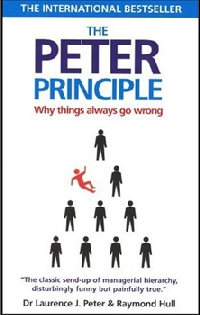 I've been thinking about how we motivate people lately, be it in the work place or in a volunteer organization and I'm of the opinion there is no single approach that is universally applicable. It's a matter of finding each person's hot button and knowing how to push it. I think the reason for this is because people today are more ruggedly independent and competitive, rather than cooperative and working as a team. Unfortunately, this complicates the life of the manager who must somehow get a group of people working towards common objectives.
I've been thinking about how we motivate people lately, be it in the work place or in a volunteer organization and I'm of the opinion there is no single approach that is universally applicable. It's a matter of finding each person's hot button and knowing how to push it. I think the reason for this is because people today are more ruggedly independent and competitive, rather than cooperative and working as a team. Unfortunately, this complicates the life of the manager who must somehow get a group of people working towards common objectives.
I've classified the various motivational techniques into "Soft" and "Hard." Soft motivation techniques are used to encourage people to think and act in certain ways primarily using the art of suggestion. Some techniques in this category are direct, but most are subliminal as we appeal to the worker's intellect, that it would be in their best interest to work or act in a certain manner. Managers may use one or more of the following techniques depending on the person and situation:
"Soft"
* Salesmanship - if the business problem or objective is properly stated and the benefits clearly defined, most people will respond accordingly, but a lot depends on how the message is presented. A word out of place or spoken without conviction and your message may be misinterpreted. It's very important to solicit understanding and get your audience shaking their heads in agreement with you thereby confirming they comprehend your message.
* Brainwashing - do not underestimate the power of repetitive messages, be it on the computer, on printed signs, audio sound bites or whatever. Repetition represents a subliminal way to motivate people. Keep your message short and sweet; also make it iconic so it triggers certain responses from your workers.
* Rewards - financial compensation, benefits, time off and even a simple luncheon represents a carrot and stick approach to motivating people. To me, this approach was more effective 20-30 years ago than it is today where employees fully expect to enjoy all of the perks a company has to offer regardless if they earned it or not.
* Elitism - creating an esprit de corps among workers has at times proven very effective. Over the years there have been several reports describing how workers who are given special preferential treatment respond enthusiastically. Giving such treatment implies promoting a worker's social standing in the company (it's a "class" thing). Elitism can take many forms, be it new facilities, use of special technology, more freedom in the workplace, more participation in project decisions, etc. If workers believe they are working on a "state of the art" project or are given star status, they tend to develop a swagger and work more earnestly as they wish to maintain their perception of self-worth. Occasionally workers abuse their stardom, at which time it is necessary for the manager to burst their bubble and bring them back to Earth.
* Interpersonal Relations - This is much more than salesmanship as it requires the use of all of a manager's rhetorical powers being applied spontaneously. Here, the manager must interact with each worker individually and thereby must know each person's hot buttons. Consequently, a manager must be able to quickly shift from being friendly and kind one moment, to satirical in the next, to consoling, to some friendly bullying, to kidding and friendly teasing, etc.
* Inspiration - this can be a very handy technique for motivating people who can be inspired through a talk or an article. If workers truly believe in their leaders, they can move heaven and earth. This of course means the development of positive role models for others to emulate. It can also be through some act a person has performed, such as some special achievement or award received. People tend to respect others they know to possess special qualities.
* Mentoring - here, the older workers offer wise counsel to younger workers and guides them through their professional development. Although mentoring was at one time a popular technique used in business, it fell into disuse for several years in the late 20th century. Only now is it beginning to make a comeback.
* Teaching - simple education through classes or seminars can inculcate important lessons and leave an indelible impression on workers.
Aside from these "Soft" motivational techniques, there are some workers who are just plain "thick" and do not take hints well. Consequently, a manager must make use of "Hard" techniques, such as:
"Hard"
* Criticism - sharp criticisms and insults regarding workmanship can sting, particularly if coworkers learn of it. Unfortunately, the only way to get some workers' attention is by questioning their professional integrity. Sometimes bullying can produce remarkable results, but I do not recommend it as a regular diet. Beware of embarrassing employees who may respond by subverting your plans. It is also a good way to create enemies. Then again, do you really care?
* Ranting and raving - loud and obnoxious outbursts demonstrate your displeasure with something and acts as a warning to all in earshot that you mean business. Most people like to avoid losing their cool, but sometimes it can really rattle the cages of workers. Think of it as an occasional stick of dynamite to move a stubborn problem out of the way.
* Threats - nobody likes to be threatened but regrettably sometimes it is necessary and certain people respond positively to it, be it a threat to employment, a cut in pay, or whatever. By putting the fear of God into someone, it's amazing what they can produce. One caveat though, check the person's work carefully as they may have cut corners or even sabotaged their work.
* Placebos - represents simple trickery, be it offering a magical pill, changing the clock, or whatever. Through simple misdirection you can induce people to produce the results you want in spite of their inclinations.
* Micromanagement - representing close supervision of the worker activities. This is primarily used in situations where the boss does not trust the judgment of the workers and finds it necessary to direct all of their activities personally. The only problem here is the manager spends more time supervising and less time managing. Further, workers no longer feel responsible for workmanship and rightfully blame the manager for any errors made.
It bothers me that we have to use "Hard" motivational techniques to produce the results we want as managers. I am the type who just needs to believe in what I am doing in order to tackle an assignment (just a little "Salesmanship"). However, not everyone is the same and it is necessary for a manager, regardless of the organizational entity, to use whatever techniques are available to get the job done. It is not surprising to see some people take on a chameleon approach to management where their disposition can change from kind and gentle to harsh and tyrannical in order to suit the moment. In fact, a good manager must possess the ability to change his/her deportment. If a manager is nothing more than a simple easygoing person, workers may be inclined to abuse him as they do not take him seriously. In contrast, if a person is a tyrant, he runs the risk of mutiny or abandonment. The manager must be willing to change his disposition to suit the situation and get the results desired. In the end, it's a matter of knowing how and when to push the hot buttons of our workers.
Keep the Faith!
Note: All trademarks both marked and unmarked belong to their respective companies.
 Tim Bryce is a writer and the Managing Director of M. Bryce & Associates (MBA) of Palm Harbor, Florida and has over 30 years of experience in the management consulting field. He can be reached at timb001@phmainstreet.com
Tim Bryce is a writer and the Managing Director of M. Bryce & Associates (MBA) of Palm Harbor, Florida and has over 30 years of experience in the management consulting field. He can be reached at timb001@phmainstreet.com
For Tim's columns, see:
http://www.phmainstreet.com/timbryce.htm
Like the article? TELL A FRIEND.
Tune into Tim's THE BRYCE IS RIGHT! podcast Mondays-Fridays, 11:30am (Eastern).
Copyright © 2010 by Tim Bryce. All rights reserved.
 Welcome to (any company using voice mail). Your call is very important to us. Listen to your options carefully:
Welcome to (any company using voice mail). Your call is very important to us. Listen to your options carefully: Tim Bryce is a writer and the Managing Director of M. Bryce & Associates (MBA) of Palm Harbor, Florida and has over 30 years of experience in the management consulting field. He can be reached at timb001@phmainstreet.com
Tim Bryce is a writer and the Managing Director of M. Bryce & Associates (MBA) of Palm Harbor, Florida and has over 30 years of experience in the management consulting field. He can be reached at timb001@phmainstreet.com Now, with just over 30 days remaining, we're coming into the home stretch of the American mid-term elections. So far, it has been an interesting race with Tea Partiers flexing their political muscles thereby putting liberal Democrats against the ropes. Prognosticators are painting a bleak picture for the Democrats in the Fall as Americans are outraged over Obamacare, deficit spending, the president's handling of the Gulf disaster, and the economy in general. If the president has been successful in anything, he has awakened conservatives and set them to work. This is bad news for incumbent Democratic congressmen who want to distance themselves from a president who is now considered political poison.
Now, with just over 30 days remaining, we're coming into the home stretch of the American mid-term elections. So far, it has been an interesting race with Tea Partiers flexing their political muscles thereby putting liberal Democrats against the ropes. Prognosticators are painting a bleak picture for the Democrats in the Fall as Americans are outraged over Obamacare, deficit spending, the president's handling of the Gulf disaster, and the economy in general. If the president has been successful in anything, he has awakened conservatives and set them to work. This is bad news for incumbent Democratic congressmen who want to distance themselves from a president who is now considered political poison. "A man has got to know his limitations." - Dirty Harry
"A man has got to know his limitations." - Dirty Harry A few nights ago, my wife and I were visiting with some friends and somehow we got on the subject of literature, specifically the books we read in High School years ago. We compiled quite a list including: "Across Five Aprils" by Irene Hunt, "Lord of the Flies" by William Golding, "Of Mice and Men" by John Steinbeck, "Madame Curie" by Eve Curie, "Moby Dick" by Herman Melville, "The Good Earth" by Pearl Buck, "The Grapes of Wrath" by John Steinbeck, "The Merchant of Venice" by William Shakespeare, "The Old Man and the Sea" by Ernest Hemingway, "The Red Badge of Courage" by Stephen Crane, "The Scarlet Letter" by Nathaniel Hawthorne, and "The Yearling" by Marjorie Kinnan Rawlings. I'm sure I have forgotten others mentioned that evening, but I think you get the idea.
A few nights ago, my wife and I were visiting with some friends and somehow we got on the subject of literature, specifically the books we read in High School years ago. We compiled quite a list including: "Across Five Aprils" by Irene Hunt, "Lord of the Flies" by William Golding, "Of Mice and Men" by John Steinbeck, "Madame Curie" by Eve Curie, "Moby Dick" by Herman Melville, "The Good Earth" by Pearl Buck, "The Grapes of Wrath" by John Steinbeck, "The Merchant of Venice" by William Shakespeare, "The Old Man and the Sea" by Ernest Hemingway, "The Red Badge of Courage" by Stephen Crane, "The Scarlet Letter" by Nathaniel Hawthorne, and "The Yearling" by Marjorie Kinnan Rawlings. I'm sure I have forgotten others mentioned that evening, but I think you get the idea. Every once and a while I have to remind myself of my roots in the Information Systems world. In an Internet discussion group I monitor, a young programmer recently lamented his department spent an inordinate amount of time in "maintenance" and not new development. I do not believe this is what he meant to say but it reflects some common misconceptions about systems and programming.
Every once and a while I have to remind myself of my roots in the Information Systems world. In an Internet discussion group I monitor, a young programmer recently lamented his department spent an inordinate amount of time in "maintenance" and not new development. I do not believe this is what he meant to say but it reflects some common misconceptions about systems and programming. We are all acutely aware of the problems in business today. It seems a day doesn't go by we don't hear of another faltering economic statistic, bankruptcy, foreclosure or whatever. It's all very depressing. Are we really so incompetent that we cannot work out of these doldrums? I think we can, but I'm not sure we're up to the challenge. I think deep down we've all known the answer to our problems, we're just not willing to address them properly. Instead we tend to adopt quick and dirty solutions that superficially satisfy our problems, hence they are never truly conquered. To illustrate, below is a list of programs proven to be effective for producing positive results in business over the years.
We are all acutely aware of the problems in business today. It seems a day doesn't go by we don't hear of another faltering economic statistic, bankruptcy, foreclosure or whatever. It's all very depressing. Are we really so incompetent that we cannot work out of these doldrums? I think we can, but I'm not sure we're up to the challenge. I think deep down we've all known the answer to our problems, we're just not willing to address them properly. Instead we tend to adopt quick and dirty solutions that superficially satisfy our problems, hence they are never truly conquered. To illustrate, below is a list of programs proven to be effective for producing positive results in business over the years. For the longest time I had trouble understanding why so many people in the entertainment industry supported liberal causes. I thought it was perhaps nothing more than a coincidence. Whereas it was common policy years ago for entertainers to bite their tongues and say nothing which may compromise their careers, today it is more likely they will speak up at every opportunity and generously support liberal causes. It is of course their right to believe in such causes, but it troubled me why the lion's share of Hollywood and the media is inclined to be liberal. Then it came to me...
For the longest time I had trouble understanding why so many people in the entertainment industry supported liberal causes. I thought it was perhaps nothing more than a coincidence. Whereas it was common policy years ago for entertainers to bite their tongues and say nothing which may compromise their careers, today it is more likely they will speak up at every opportunity and generously support liberal causes. It is of course their right to believe in such causes, but it troubled me why the lion's share of Hollywood and the media is inclined to be liberal. Then it came to me...
 Ever notice when the media tries to slip something into our thought processes? It may seem innocent on the surface, but it actually has some subliminal meaning. Maybe it's a new fashion statement or perhaps a new word added to our vernacular. They slip it in then build on it until it is an accepted concept. For example, the media has been increasingly talking about "Progressive" Democrats as if they are just that, people interested in implementing positive changes to our government. If you listen to the press carefully, you would get the impression that "progressives" are either moderates or possibly even conservatives. I'm sorry, this is just not so as "progressives" actually represent the left side of American politics.
Ever notice when the media tries to slip something into our thought processes? It may seem innocent on the surface, but it actually has some subliminal meaning. Maybe it's a new fashion statement or perhaps a new word added to our vernacular. They slip it in then build on it until it is an accepted concept. For example, the media has been increasingly talking about "Progressive" Democrats as if they are just that, people interested in implementing positive changes to our government. If you listen to the press carefully, you would get the impression that "progressives" are either moderates or possibly even conservatives. I'm sorry, this is just not so as "progressives" actually represent the left side of American politics. Many years ago, early in my career, I was meeting with a client in Canada where we were discussing the characteristics of a good manager. My friend made the observation that the true hallmark of a good manager is "He does himself out of a job." This means the manager has groomed his staff into running the department smoothly even when the manager was absent from the office. I accept this premise and have passed it on to others over the years.
Many years ago, early in my career, I was meeting with a client in Canada where we were discussing the characteristics of a good manager. My friend made the observation that the true hallmark of a good manager is "He does himself out of a job." This means the manager has groomed his staff into running the department smoothly even when the manager was absent from the office. I accept this premise and have passed it on to others over the years. If you ever owned a dog, you've probably got a favorite story you like to tell, all dog owners seem to have such an affliction; here's mine.
If you ever owned a dog, you've probably got a favorite story you like to tell, all dog owners seem to have such an affliction; here's mine. Every now and then something sets me off about the computer industry and reminds me how screwed up it is. This past week I heard three expressions bandied about which have been around for a number of years and frankly, I had hoped they had died off.
Every now and then something sets me off about the computer industry and reminds me how screwed up it is. This past week I heard three expressions bandied about which have been around for a number of years and frankly, I had hoped they had died off. We just sold our 2000 Volkswagen Beetle. It was a beautiful car which was painted red and featured a 4 Cyl. GLS 1.8 Liter Turbo engine. This was definitely not your father's VW as it had a lot of get up and go. One time I had it up to 120 mph just to see what it could do. I could have gone faster, but 120 was fast enough for me. Other than a few trips to Jacksonville, Orlando, and Naples, the car didn't get much use and shuttled me to and from work or to the airport. As my kids grew up, we rarely drove it anymore. When we sold it, there was just over 50,000 miles on it, not bad for a ten year old car. It was well maintained over the years, but it simply sat in our driveway with the Florida sun pounding on it, which is why we finally decided to sell it to someone who could take better care of it.
We just sold our 2000 Volkswagen Beetle. It was a beautiful car which was painted red and featured a 4 Cyl. GLS 1.8 Liter Turbo engine. This was definitely not your father's VW as it had a lot of get up and go. One time I had it up to 120 mph just to see what it could do. I could have gone faster, but 120 was fast enough for me. Other than a few trips to Jacksonville, Orlando, and Naples, the car didn't get much use and shuttled me to and from work or to the airport. As my kids grew up, we rarely drove it anymore. When we sold it, there was just over 50,000 miles on it, not bad for a ten year old car. It was well maintained over the years, but it simply sat in our driveway with the Florida sun pounding on it, which is why we finally decided to sell it to someone who could take better care of it. Conservatives have difficulty understanding their liberal counterparts, particularly the far left. This is primarily due to the conflicting value systems between the two groups which are distinctly different. Conservatives tend to possess a John Wayne-esque sense of right and wrong, that they should be moral and responsible citizens, work hard, play fair, and help their neighbors. It is beyond their comprehension that anyone would think otherwise, and therein lies their weakness, they believe everyone is playing by a uniform set of rules. They're not. The radical left is engaged in a holy war or Jihad against the fundamental tenets of the United States and want to transform it into something they themselves do not comprehend, namely chaos whereby right appears to be wrong and vice versa.
Conservatives have difficulty understanding their liberal counterparts, particularly the far left. This is primarily due to the conflicting value systems between the two groups which are distinctly different. Conservatives tend to possess a John Wayne-esque sense of right and wrong, that they should be moral and responsible citizens, work hard, play fair, and help their neighbors. It is beyond their comprehension that anyone would think otherwise, and therein lies their weakness, they believe everyone is playing by a uniform set of rules. They're not. The radical left is engaged in a holy war or Jihad against the fundamental tenets of the United States and want to transform it into something they themselves do not comprehend, namely chaos whereby right appears to be wrong and vice versa. I have written in the past about how our personal appearance sends signals to others as to what type of person we are, e.g.; clean and neat versus sloppy and poorly groomed (see
I have written in the past about how our personal appearance sends signals to others as to what type of person we are, e.g.; clean and neat versus sloppy and poorly groomed (see  The legendary "King of Late Night," Johnny Carson, was back in the news last month, five years after his passing. It was announced that all of his Tonight Show episodes (from 1962 to 1992) have been restored and digitized and will be made available over the Internet and in DVD. This means Johnny will live on for many more years, well beyond Leno, Letterman, et al.
The legendary "King of Late Night," Johnny Carson, was back in the news last month, five years after his passing. It was announced that all of his Tonight Show episodes (from 1962 to 1992) have been restored and digitized and will be made available over the Internet and in DVD. This means Johnny will live on for many more years, well beyond Leno, Letterman, et al. The November mid-term elections are just around the corner and they are shaping up to be one of the most interesting in recent history. Not since the 1960's have I seen the country so politically charged. Political scientists and the media will be watching with bated breath as this election may very well have an impact on the 2012 presidential election.
The November mid-term elections are just around the corner and they are shaping up to be one of the most interesting in recent history. Not since the 1960's have I seen the country so politically charged. Political scientists and the media will be watching with bated breath as this election may very well have an impact on the 2012 presidential election. I've been thinking about how we motivate people lately, be it in the work place or in a volunteer organization and I'm of the opinion there is no single approach that is universally applicable. It's a matter of finding each person's hot button and knowing how to push it. I think the reason for this is because people today are more ruggedly independent and competitive, rather than cooperative and working as a team. Unfortunately, this complicates the life of the manager who must somehow get a group of people working towards common objectives.
I've been thinking about how we motivate people lately, be it in the work place or in a volunteer organization and I'm of the opinion there is no single approach that is universally applicable. It's a matter of finding each person's hot button and knowing how to push it. I think the reason for this is because people today are more ruggedly independent and competitive, rather than cooperative and working as a team. Unfortunately, this complicates the life of the manager who must somehow get a group of people working towards common objectives. Have you ever been a project manager and found yourself spending an inordinate amount of time simply keeping the project team synchronized? Or perhaps a department manager trying to keep all of your people gainfully employed? It should come as no small surprise that managers probably spend at least 25% of their time communicating with their people, regardless if the organization is well structured and disciplined. Communications plays a significant role in any organization, but many fail to grasp the simple complexity of communications. Let's begin by understanding the number of lines of communications between people. Interestingly, the number of lines of communication grows exponentially based on the number of people involved. For example:
Have you ever been a project manager and found yourself spending an inordinate amount of time simply keeping the project team synchronized? Or perhaps a department manager trying to keep all of your people gainfully employed? It should come as no small surprise that managers probably spend at least 25% of their time communicating with their people, regardless if the organization is well structured and disciplined. Communications plays a significant role in any organization, but many fail to grasp the simple complexity of communications. Let's begin by understanding the number of lines of communications between people. Interestingly, the number of lines of communication grows exponentially based on the number of people involved. For example: